Types of Compressor and Structure
Types of Compressor and Structure: Swash Plate Type (Fixed Displacement)
Structure
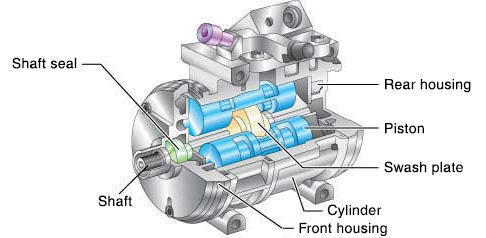
This pistons is constructed from the components shown in the illustration.
The pistons move back and forth when power from the engine causes the shaft and swash plate to rotate.
One piston is comprised of cylinders on both sides. The ends of the piston intake pressurize and discharge refrigerant.
Actuation
In the cylinder shown in the right of the illustration, the suction valve is opened when the piston moves to the left. The pressure difference between the suction shaft within the housing and inside the cylinder causes refrigerant to enter the cylinder through the suction valve. Conversely, when the piston moves to the right, the suction valve is closed and the refrigerant is pressurized. Continued pressurization increases the pressure of the refrigerant in the cylinder, causing the discharge valve to open. The refrigerant then flows to a high-pressure pipe. (The suction and discharge valves prevent flow back of the refrigerant.) The balance of characteristics and reliability in this compressor make it suitable in a wide-range of vehicles around the world, such as small vehicles, mini-vans, large busses, and construction equipment.
You can find more about our swash plate type compressors.
Types of Compressor and Structure: Vane Type (Fixed Displacement)
Structure
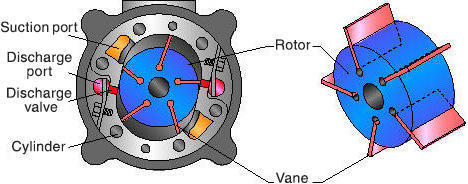
This compressor is constructed from cylinders and five vanes built into the rotors, as well as two discharge valves and front and back side plates. The five vanes rotate in tandem with the rotors while contacting the wall inside the cylinder.
Operation
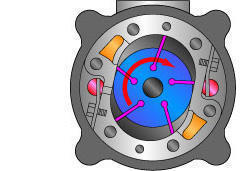
Cylinder volume increases with rotor rotation, causing refrigerant to flow into the cylinder shaft from the suction port. The refrigerant is sealed within the cylinder by the vanes, and is compressed by the rotation of the rotor. It is then discharged from the discharge port once it reaches outlet pressure. The compressor is equipped with two suction and discharge ports. Refrigerant is discharged 10 times for each rotation.
You can find more about our vane type compressor.
Types of Compressor and Structure: Scroll Type (Fixed Displacement)
Structure
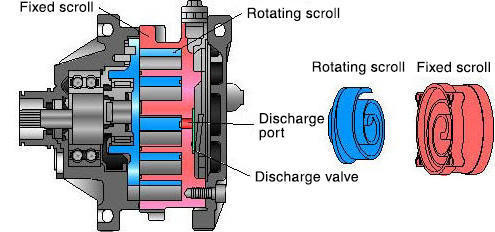
This compressor is constructed from one fixed and one rotating scroll in an offset spiral configuration. Shaft rotation creates spaces of varying volume between the 2 scrolls, causing refrigerant to be sucked in and compressed.
Operation
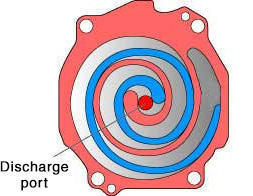
As the rotating scroll moves, the space between the two scrolls also moves, causing the volume of this space to gradually decrease. Refrigerant flows in from the suction port and is gradually compressed by the rotating scroll rotation. It is discharged from the discharge port after approximately 3 rotations. Refrigerant is actually discharged once for each rotation. It is an extremely quiet and efficient compressor used mostly in small and light cars.
You can find more about our swash plate type compressors.
Types of Compressor and Structure: One-Way Swash Plate Type (Variable Displacement)
Structure
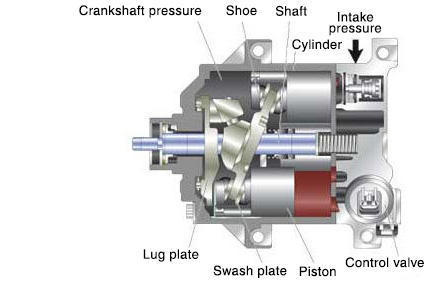
The illustration shows the construction of this compressor. Refrigerant intake and compression methods are almost the same as those for the fixed displacement swash plate compressor. Unlike the fixed displacement type, however, there is only one cylinder.
Operation
The required amount of refrigerant gas is sucked in and compressed by changing the pressure balance within the compressor. The swash plate angle can be adjusted, which forces the piston to make larger or smaller strokes. This enables stable temperature control and improved driving feeling. Displacement control can be achieved by either internally controlled variable displacement or externally controlled variable displacement methods.
Internally Controlled Variable Displacement Method
The compressor controls optimum capacity according to the heat load of the compressor, with the control valve sensing the changing intake pressure of refrigerant gas. This enables smooth operation and quick temperature control.
One-Way Swash Plate Internally Controlled Type
Externally Controlled Variable Displacement Method
An electric signal is sent to the compressor control valve from outside the vehicle. Finely tuned optional control is possible for the compressor to operate at optimum capacity, enabling greater fuel efficiency to be achieved.
